If you’ve never had a baby before, you may not know what is normal when it comes to infant eye health. Should you be disturbed that your baby doesn’t seem to recognize you? What if his or her eyes don’t seem to be working together?
A baby’s vision develops over time, especially during the first six months after birth. As a result, some behaviors that are cause for concern in adults are perfectly normal for babies. The key is knowing when to relax and when to see an eye doctor to make sure your baby is all right.
Newborn
At birth, babies can barely see at all, and what they can see is very blurry. In fact, a newborn can see only about 8 to 12 inches away from his or her face, or about the distance from the baby’s face to the parent’s face while the child is in the parent’s arms.
Research shows that within a few days after birth, a baby prefers his or her mother to strangers. However, studies show that this is likely because babies can detect the contrast between people’s hairlines and foreheads; when mothers’ hairlines are obscured, the babies’ indications of recognition go away.
If your baby is a newborn and doesn’t seem to recognize you when your hairline is hidden, such as with a hat, then your baby’s confusion shouldn’t trouble you. However, if your hairstyle remains the same and your baby consistently doesn’t seem to prefer you to strangers, then you may want to see a doctor.
During the newborn phase, you can promote healthy eye development by interacting with your child within his or her field of vision. Hold your child about 8 to 12 inches away from your face while you talk to him or her. You might also try making different facial expressions at your baby.
One Month
Color vision, the ability to use the eyes in tandem, the ability to track objects, and viewing attention span also increase over time. By the age of about one month, an infant may start to track objects with the eyes, turn his or her head toward light, and focus on or make eye contact with caregivers.
Before this point, it’s normal for a baby’s eyes to not always move together. An eye may wander sometimes, or your baby’s eyes may even cross. If the behavior isn’t consistent, then you have no cause for concern. However, if your baby’s eyes are consistently crossing or regularly manifesting a specific, unusual behavior, then an optometrist may need to examine your child’s eyes.
When your baby is about a month old, you can try showing him or her brightly colored toys and moving things across your child’s field of vision. For example, rattles can be intriguing to one-month-olds.
Two to Six Months
Between the ages of two and six months, a baby’s vision and understanding of the world improves dramatically. Abilities regarding color vision, attention span, and the tracking of objects continue to improve, and your baby will start to move his or her eyes independently of the head and recognize people’s faces.
Your child will also eventually become interested in his or her own reflection, hands, and feet. As your baby draws closer to the six-month milestone, his or her depth perception will start to improve, and he or she will begin to reach for and grasp objects within view.
During this time, brightly colored toys as well as high-contrast designs and images can be extremely helpful. As your child continues to grow, you can focus more on sharing pictures, books, and hand-held toys.
Additional Guidelines
Every child develops at a slightly different rate, so there aren’t exact dates at which your baby has to hit certain milestones. However, normal eyesight should in general develop along typical timelines. In other words, while milestones are not deadlines, the fact that your baby cannot yet speak doesn’t prevent you from monitoring your child’s vision and development.
Furthermore, while significant departure from standard development timelines is one cause of concern, you should also watch out for clear signs of illness.
Your child’s pediatrician should check your baby’s eyesight at every visit, and your child should have an eye exam with an optometrist when he or she is six months old.
If you have specific cause for concern, then you may want to see an eye doctor before your baby is six months old. Glaring signs that your child needs to see an eye doctor include symptoms that are abnormal for anyone, such as hypersensitivity to light, a white pupil, red eyelids, or constant tearing.
Remember, you as a parent know your child best, so trust your instincts: if you think something is wrong, then take your baby to see a doctor.
When your baby reaches his or her sixth month, or if you have a concern you’d like a professional’s opinion on, come see an eye doctor at All About Eyes. Contact us today to reserve your baby’s first eye exam. We’ll be happy to help you.

